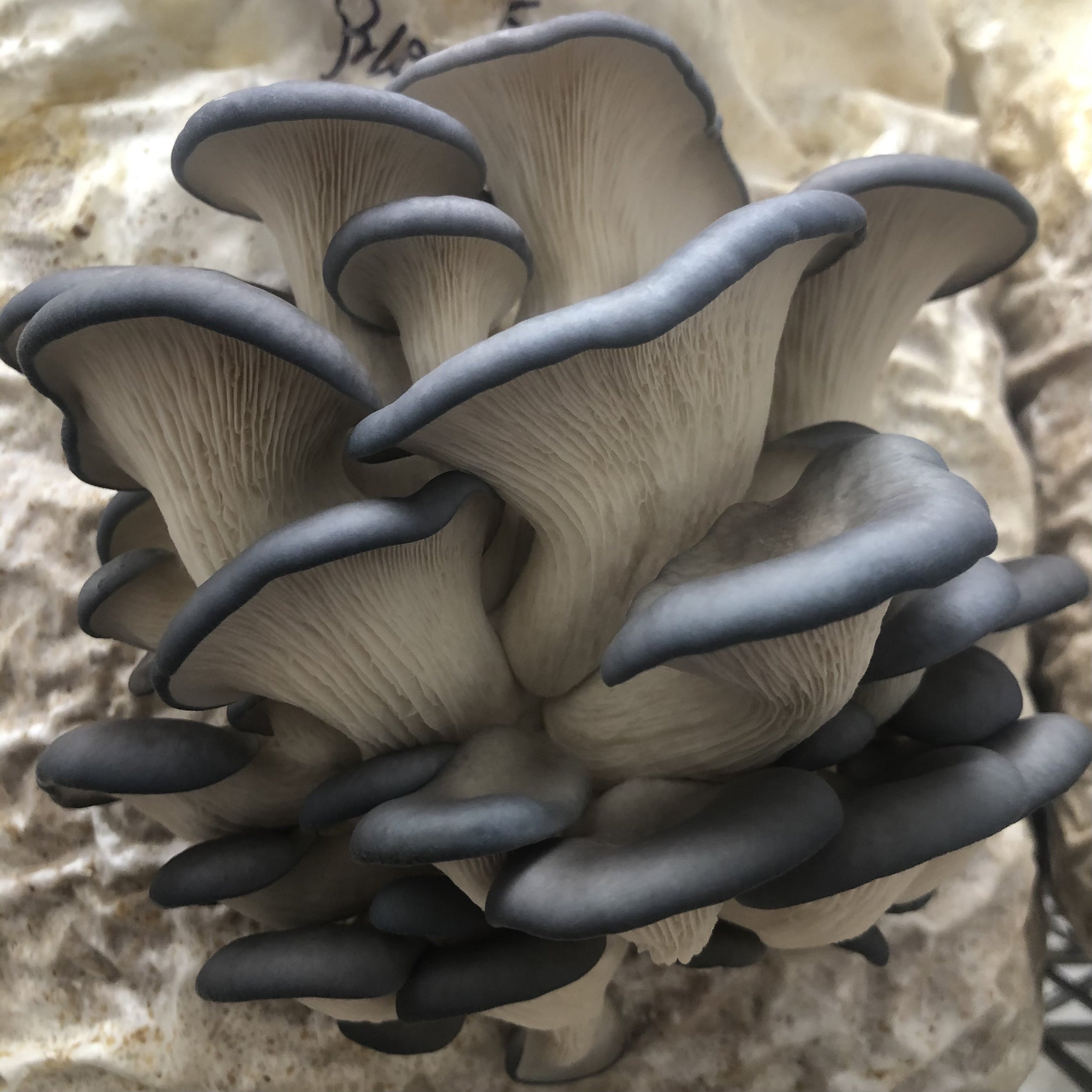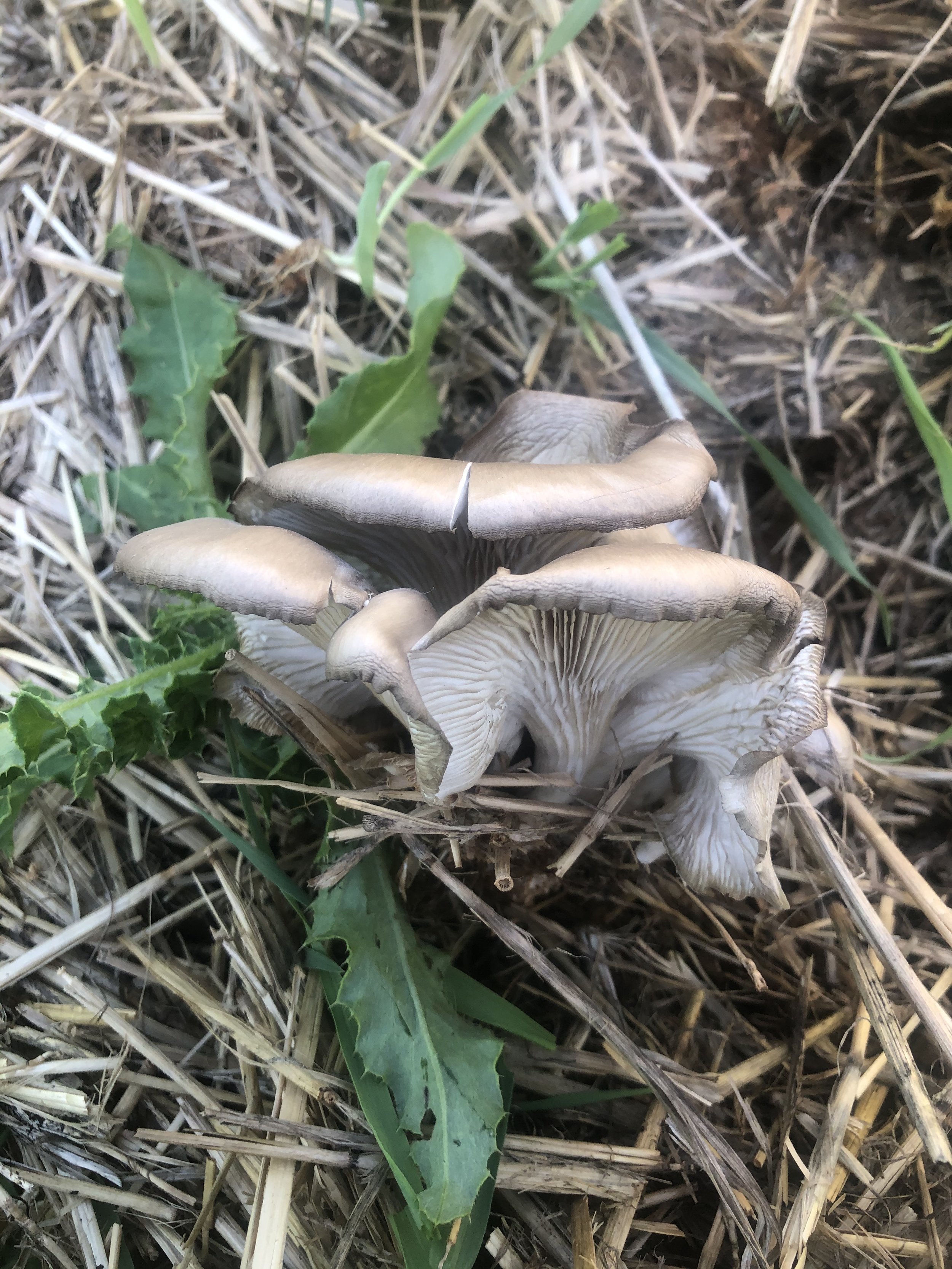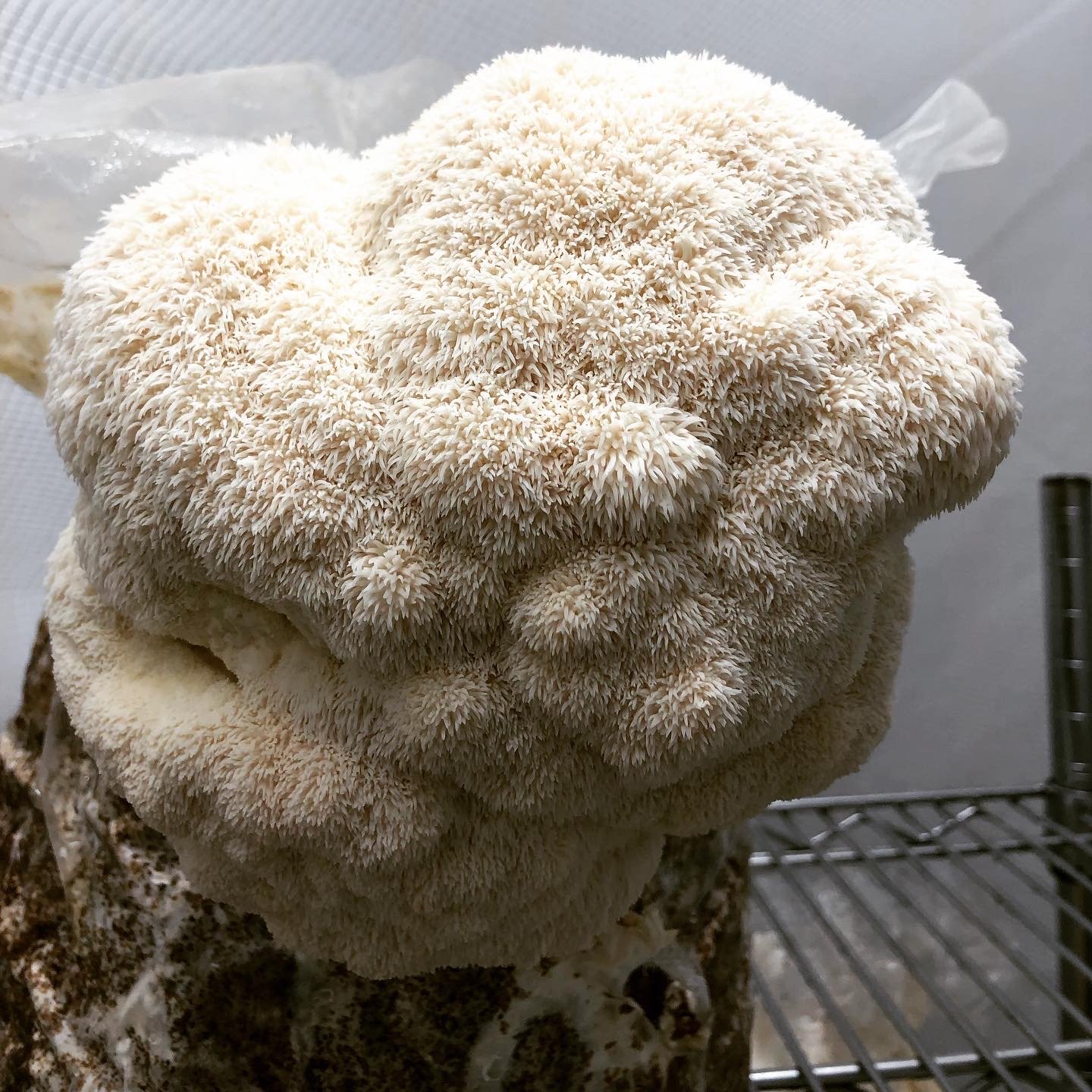Blue/White Oyster
A great choice for beginner growers.
Easy to grow
-
Cool to Room temperature (16-21)
Indirect sunlight or ambient household light.
Place the bag on a tray or in a tote to catch water
-
Cut a 5”x5” X in the bag. This will introduce your mushrooms to fresh air.
Mist the bag with water. This will emulate a fresh rain.
-
Mist 2-4 times per day. partially covering with a bag or tote can help keep humidity high.
You should see mushroom pins start to develop 5-10 days after initiation.
As the mushrooms start to develop, be careful not to pelt them with water. Spray around them, and from a distance to create a mist.
Oysters also like a lot of fresh air. Arrange your setup in such a way to allow them to have constant or regular airflow.
-
7-10 days after pinning, the handful cluster is ready to harvest. The caps should still be flat or slightly turned under. When the caps begin to turn upwards, they start to drop spores and the quality and shelf life decrease.
-
detach cap from the stem with scissors or knife.
Sautee caps in butter and salt
mince the stems. add garlic salt and cream to make a sauce, add stock to make a soup.
Put simply, mushrooms can with added to any savory dish.
-
If caps are small, and stems are elongated, increase fresh air exchange.
Mold/contamination is inevitable beyond the fruiting phase, Contact us if you have mold before your first flush.
-
Source or protein and fiber and B vitamins
Blood sugar regulation,
Anti-inflammatory
Cholesterol lowering properties
Immune support
Lions Mane
A great culinary and medicinal mushroom.
-
Cool to Room temperature (16-21)
Indirect sunlight or ambient household light.
Place the bag on a tray or in a tote to catch water
-
Cut a 5”x5” X in the bag. This will introduce your mushrooms to fresh air.
Mist the bag with water. This will emulate a fresh rain.
-
Mist 2-4 times per day. partially covering with a bag or tote can help keep humidity high.
You should see mushroom pins start to develop 5-10 days after initiation.
As the mushrooms start to develop, be careful not to pelt them with water. spray around them, and from a distance to create a mist.
-
12-18 days after pinning, it should be ready to harvest. the teeth or spines should be visa le but under 1/4’’ long
Simply pull with a slight twist to detach the mushroom from the block.
continue to mist after harvest for 1-2 additional harvests
-
Slice, dice or peel. just make sure to cook before eating.
-
If mushrooms are starting to turn yellow, the may be drying out. if you ae satisfied with the size, it may be a good time to harvest and re-initiate
-
Lions mane is used as a nervine tonic for nervous system support, which can reduce tension, inflammation, stress and boost cognition.
Black Pearl
King Oyster
-
Cool to Room temperature (16-21)
Indirect sunlight or ambient household light.
Place the bag on a tray or in a tote to catch water
-
Cut the top of the bag off just beneath the seal, and allow the mushrooms to “top fruit”.
lightly mist the inside of the bags and pinch the bag loosely-closed with a clothes pin.
-
Mist 2-4 times per day. partially covering with a bag or tote can help keep humidity high.
You should see mushroom pins start to develop 5-10 days after initiation.
As the mushrooms start to develop, be careful not to pelt them with water. spray around them, and from a distance to create a mist.
-
Pins 7-10 days after pinning, the handful cluster is ready to harvest. The caps should still be flat or slightly turned under. when the case begin to turn upwards, they start to drop spores and the quality and shelf life decrease.
Harvest by pulling/twisting mushrooms to detach from the block. Trim the substrate from the base and they’re ready to eat.
-
Since the stems are tender, we like to slice them lengthwise to make nice long strips. paprika salt and maple syrup will make a nice vegan bacon
-
Black Pearls love to top fruit. make sure you cut the top of the bag to encourage it.
if mushrooms fail to produce, it may be too hot. try waiting a few weeks for cooler weather and re-initiate.
-
Source or protein and fiber and B vitamins
Blood sugar regulation
Anti-inflammatory
Cholesterol lowering properties
Immune support
Shiitake
-
Cool to Room temperature (16-21)
Indirect sunlight or ambient household light.
A cleat tote (60L-80L) with lid can be helpful
-
Remove shitake block completely from the bag.
Mist the block and tote with water.
-
Mist 2-4 times per day. partially covering with a bag or tote can help keep humidity high. Shiitake can withstand higher C02 concentrations, so fresh air isn’t as crucial. Using a tote with lid loosely ajar can be advantageous.
As the mushrooms start to develop, be careful not to pelt them with water. spray around them, and from a distance to create a mist.
-
7-10 days after pinning, the handful cluster is ready to harvest. The caps should still be flat or slightly turned under. when the case begin to turn upwards, they start to drop spores and b thquality and shelf life decrease
-
Stems are tougher to they can de detached and used to add flour to stock. They can also be dried and powdered.
Caps can be sauteed and added to any savory dish. The flavor goes especially well with asian soups and noodle dishes.
-
If blocks aren’t fruiting, try re-initiate by soaking them for 24 hours in cold water, draining and continuing to mist on a daily basis.
-
Immune boosting
Cholesterol lowering
Blood sugar modulator
anti-inflammatory
King Stropharia (Wine Cap)
An exclusively outdoor growing mushroom. If supplied with fresh wood chips every year. A great choice for gardens, and permanent installs.
-
Choose an area outdoors. partially shaded, filtered sunlight, easily monitored (for harvest) area. King Stopharia thrives in moist fertile soil, with good drainage.
You will need:
Hardwood chips or sawdust,
Chopped straw (optional)
Corrugated cardboard
-
stake out a 4x4 patch.
loosen or till the soil, ideally mixing in some chopped straw to penetrate the soil with fresh organic matter.
a base of soaked cardboard followed by a sprinkling of mushroom mycelium.
Continue to layer fresh substrate (wood chips, sawdust, straw) with mushroom mycelium eventually topping it with an inch of substrate.
water the bed and monitor closely for the first few weeks to maintain the “moist, but not wet” environment.
-
On a dry year, check in to water as needed.
Add fresh woodchips to the bed every year or 2 to maintain the health and encourage growth of the mycelium.
As the bed grows, colonized substrate can be used as inoculant for subsequent mushroom bed installations.
-
It can take up to a yea to harvest your first crop and shouldn’t take any longer than 2 years.
Mushrooms have the best flavor and texture when harvested young, in their “button” stage, just before the veil breaks on the underside of the cap.
-
Mushrooms can be chopped sliced, diced. They taste particularly nice in a cream soup or simply sauteed as a side dish.









